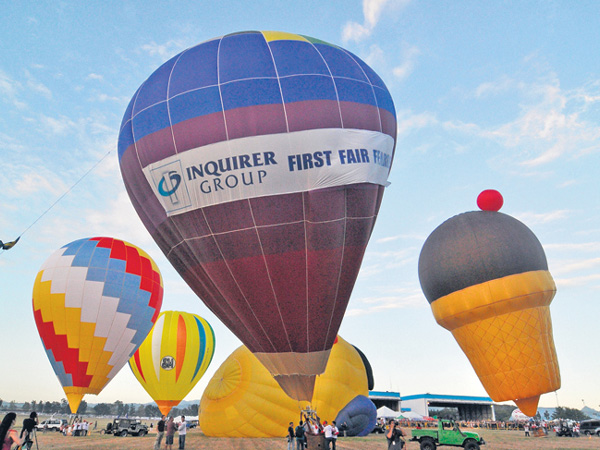Hot air balloons color skies, lift up spirits

17TH EDITION The Inquirer Group hot air balloon prepares to take off during Thursday’s kick-off of the four-day Philippine International Hot Air Balloon festival at Clark Freeport in Pampanga province. The festival, which draws tens of thousands of foreign and local tourists, has attracted 28 balloonists from Asia, the Pacific, Europe and the United States. RICHARD REYES
CLARK FREEPORT—Three years after the destructive 1991 eruptions of Mt. Pinatubo, residents of Angeles City and Mabalacat in Pampanga province woke up in awe on seeing gigantic balloons of different colors gliding in the sky.
“I just got up from my bed when I heard children outside shouting. They were running and pointing at the sky. When I raised my head, I saw this big balloon above,” recalled Edgar Cunanan, 44, a resident of Dau in Mabalacat.
“It was really big. My neighbors also went out of their houses and we saw there were other giant balloons in the sky.”
The hot air balloons seen by Cunanan and his neighbors were among the dozen participants in that first hot air balloon festival launched by then Tourism Secretary Mina Gabor at the height of the volcanic lahar onslaught in 1994.
The event aimed to uplift the spirit of the people of Pampanga and those in other parts of Central Luzon devastated by Mt. Pinatubo’s eruptions and volcanic mudflows.
Article continues after this advertisementTourism show
Article continues after this advertisementAided by Joy Roa, a Filipino hot air balloon enthusiast, Gabor commissioned South Korean balloon pilot Sung Kee Paik and British Airways general manager John Emery to organize the hot air balloon festival at the parade grounds here.
Today, hot air balloons no longer amaze residents of communities around Clark. They have become accustomed to seeing colorful balloons floating in the sky four days in a row every February.
The display and flight of the propane-powered air ships continued until 1998. In 1999 the event was canceled due to several problems, like insufficient operational funds and possible interruption of flights at Diosdado Macapagal International Airport here.
What was originally intended as a spirit-uplifting occasion for the people of lahar-ravaged provinces had also become a successful fund-generating tourism event in this abandoned US military base, now a major economic hub and freeport zone.
The festival was offered free to the public in its first few years. But organizers later collected fees, called “contributions,” from spectators who wanted to enter the festival venue.
Helping poor students
Last year’s P150-per-person contribution was raised to P200 this year.
In its website, the Philippine International Hot Air Balloon Fiesta (PIHABF) Foundation Inc., the primary organizer of the festival, said the fee would allow a person to stay at the event site for the whole day. The money is being used to organize the show and for the benefit of poor high school graduates aspiring for a career in aviation.
Butch Duque, media coordinator of the foundation, said the organizers had to adjust the amount collected from the public because festival expenses had increased.
“This year’s event was nearly postponed because some sponsors, whose participation is crucial, did not commit early. Fortunately, they eventually agreed to sponsor this year’s event,” he said.
Courier giant United Parcel Service (UPS), which transports the balloons, baskets and equipment of balloonists, is among the sponsors that ensure the success of the yearly event, said Duque.
Riding the balloons
For $200 (P8,450) per person, spectators aged 10 and above can also ride a hot air balloon. The “contribution” covers fuel and pilot’s expenses.
At this year’s 17th Hot Air Balloon Fiesta, which started on Thursday and is to end on Sunday, organizers expect 100,000 local and foreign tourists to flock to this freeport. Last year, some 80,000 tourists watched the event, creating traffic jams.
Like a cake
Aside from Filipinos, balloonists from the United States, Sweden, Switzerland, Germany, the United Kingdom, The Netherlands, Finland, Hungary, Thailand, Japan, Malaysia and South Korea joined this year’s event.
Twenty-one hot air balloons took off from the Philippine Air Force aviation area during the early morning “fly-out” on Thursday. Balloons shaped like a cake, ice cream in a cone and a car were among those that joined the opening.
Duque said 27 balloons were expected to join the morning and late afternoon flights until Sunday.
The balloons float with the wind. They rise in the air because hot air is lighter than cool air.
Hot air balloons usually fly early in the morning and late in the afternoon because these are the times of the day when the wind is most calm, organizers said.
The inflating of balloons usually takes 15 to 45 minutes, depending on the capabilities of the ground crew or their equipment.
Since balloons travel at the same speed as they move with the wind, the competition is not about speed or time but which balloon arrives closest to the predetermined target.
A balloonist drops a marker at a designated landing point after continually changing altitude to reach the target.